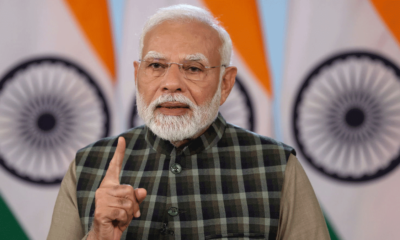Tech
Tech Layoffs Surge AI Transforms India’s Workforce
AI is rapidly changing the tech industry, causing major layoffs, especially in repetitive roles. India faces challenges but also opportunities for reskilling its workforce.

The rise of artificial intelligence (AI) is reshaping the global tech industry, bringing both innovation and disruption. Between 2022 and April 2024, more than 500,000 jobs were lost in the tech sector worldwide, with India, a major IT services hub, facing significant layoffs. As companies rapidly adopt AI technologies, many jobs, especially those involving repetitive tasks, are being replaced by automation.
“How AI is Changing the Job Market”
AI-driven automation has become a key factor in reshaping the tech industry.
Tasks like software testing, basic coding, and system maintenance, which once required human workers, are now done by AI systems more efficiently. While this shift helps companies save money and increase productivity, it also makes many traditional roles obsolete, resulting in widespread tech layoffs.
Vineet Nayar, former CEO of HCL Technologies, has expressed concerns about the future of tech jobs. He predicts that AI could replace up to 70% of jobs in India’s IT sector, particularly those involving repetitive tasks. As AI continues to take over these jobs, workers must adapt or risk losing out on future opportunities in the evolving AI workforce.
“Impact on India’s IT Sector”
India’s IT services industry has been heavily impacted by AI.
Major IT companies like Infosys, Wipro, and Tata Consultancy Services (TCS) are scaling back their hiring and focusing on retraining existing employees. This shift highlights the growing need for professionals to upskill in emerging technologies, including AI and machine learning.
The demand for skills in AI development, machine learning, and data analytics is rising rapidly. However, many workers, particularly those in traditional roles, are struggling to keep up with these changes. For India to remain competitive, its workforce must quickly learn and adapt to these new technologies and fill the rising demand for AI job opportunities.
“Global Trends and India’s Challenges”
The surge in tech layoffs globally underscores the volatile nature of the tech industry in the age of AI.
India, a central player in global IT outsourcing, faces challenges in keeping up with AI’s impact on job roles. Even startups in India, known for their innovation, are downsizing due to funding constraints and the rapid adoption of AI solutions.
While these disruptions are significant, they also present opportunities for growth and change.
“Reskilling and New Opportunities”
In response to the surge in AI job losses, both the Indian government and private institutions are focusing on reskilling programs.
These initiatives aim to equip workers with skills in AI, machine learning, and cloud computing, helping them keep pace with the evolving job market. Universities and training centers are updating their curricula to include courses on AI and data science, preparing the next generation for the AI workforce.
The rise in demand for AI specialists has created new job opportunities. Companies are actively seeking professionals who can design, implement, and manage AI systems. Those who can bridge the skills gap will find lucrative career prospects in this growing field, fueling new AI job opportunities.
“The Road Ahead: Embracing AI for Future Growth”
AI is set to play a dominant role in the future of the tech industry, and India must adapt to this change.
While short-term job losses are challenging, the long-term potential for AI-driven growth is enormous. To thrive in the evolving landscape, India needs to invest in reskilling initiatives and encourage talent development in emerging technologies.
By focusing on upskilling and embracing AI, India can transform current disruptions into long-term success. As AI continues to evolve, India’s ability to innovate and adapt will be key to maintaining its position as a global leader in the tech industry.
Watch and Subscribe to the YouTube Channel: EBT Entrepreneur Business Times
Useful Topics:
Entrepreneur Business Times | EBT – Entrepreneur Business Times | Entrepreneurship Latest News & Headlines | Business News | Startup News | CEO Interviews | Automotive News | Pharmaceutical News | FMCG News | Electric Vehicle News | Electrical and Electronics News | Sanitary and Hardware News | Technology News | Politics News | Fashion News | Sports News | Education News | Entertainment News | Video| Entrepreneur Media India | Business News Live | Share Market News | Business Times | Entrepreneurship News India | Entrepreneurship News today | Awards for entrepreneurs in India | Young Entrepreneur Awards India | Latest entrepreneurs in India | Starting a Business | Entrepreneurship in India | Entrepreneur Magazine | Business News Live | Entrepreneur Motivation | Entrepreneur Mindset | Entrepreneur podcast | Entrepreneur | How to become an Entrepreneur | How to be an entrepreneur
Tech
ISRO Plans Chandrayaan 4 – Gaganyaan Future
Dr. V Narayanan’s leadership at ISRO aims to push India’s space exploration efforts to new heights, with upcoming missions like Chandrayaan-4 and Gaganyaan.

India’s space exploration is about to enter an exciting new chapter with Dr. V Narayanan at the helm of the Indian Space Research Organisation (ISRO). Narayanan, known for his expertise in space missions, has unveiled an ambitious roadmap focusing on key space missions like Chandrayaan-4 and Gaganyaan. These initiatives are set to push India’s space efforts to new heights, further strengthening India’s space program on the global stage.
“Chandrayaan-4: Expanding Lunar Exploration”
Following the success of Chandrayaan-3, which made history with India’s first soft landing near the Moon’s south pole, ISRO is now setting its sights on Chandrayaan-4.
Dr. Narayanan shared that this mission will build on the previous achievements, with the primary goal being the detailed study of the Moon’s surface, geology, and resources. “Chandrayaan-4 will continue our journey to explore the Moon and solidify India’s position in global space research,” Narayanan stated.
This mission will likely include a more advanced rover and cutting-edge scientific instruments. Furthermore, Narayanan hinted that ISRO is exploring international partnerships to access advanced technologies that will enhance the mission’s success. Chandrayaan-4 will play a pivotal role in advancing lunar exploration, establishing India as a leader in space exploration.
“Gaganyaan: India’s Historic Human Spaceflight Mission”
Another key mission is Gaganyaan, India’s first human spaceflight program. Scheduled for late 2025, this mission marks a significant milestone for ISRO.
The first unmanned test flight, completed in late 2024, demonstrated that critical systems like crew escape and recovery are ready for the crewed mission.
“Gaganyaan is more than sending people to space; it’s about building capabilities that will redefine India’s role in space exploration,” Narayanan explained. This mission is expected to open doors for future projects like space tourism and even the development of India’s space station. Gaganyaan will not only be a milestone in human spaceflight but also lay the foundation for future endeavors in space science and technology.
“Dr. Narayanan’s Vision for ISRO’s Growth”
Dr. Narayanan has outlined several key focus areas to guide ISRO’s growth and ensure India’s leading role in global space exploration:
- Satellite Capabilities: Enhancing satellite technology for better communication, navigation, and Earth observation. This will support both civilian and defense sectors, boosting India’s capabilities in space.
- Deep Space Missions: Expanding beyond the Moon to explore Mars, Venus, and other space bodies, with a strong focus on innovation and technological breakthroughs. These missions will help India lead the way in deep space exploration.
- Commercial Space Opportunities: Strengthening collaborations with private space companies and startups to foster a robust commercial space ecosystem. This will enable India to compete globally in commercial space ventures.
- Sustainability in Space: Promoting responsible space usage by addressing issues like space debris and supporting eco-friendly propulsion technologies. Ensuring sustainability in space exploration is key to maintaining long-term viability.
“Inspiring India’s Next Generation of Scientists”
Dr. Narayanan also emphasized the importance of inspiring India’s youth to pursue careers in space science and technology.
“India’s youth are our greatest asset. We must encourage them to dream big and allow them to contribute to our space endeavors,” he said.
To this end, ISRO plans to launch several outreach programs and initiatives aimed at nurturing young talent and preparing the next generation of space scientists. These efforts will help develop the future leaders of space exploration in India.
Conclusion: A New Era for ISRO
Under Dr. V Narayanan’s leadership, ISRO is poised to achieve new milestones with its bold plans for Chandrayaan-4, Gaganyaan, and beyond. These space missions are just the beginning. With these ambitious missions, India will continue to make a lasting impact on the global space stage. As Narayanan aptly said, “The sky is not the limit; it is just the beginning.”
Watch and Subscribe to the YouTube Channel: EBT Entrepreneur Business Times
Useful Topics:
Entrepreneur Business Times | EBT – Entrepreneur Business Times | Entrepreneurship Latest News & Headlines | Business News | Startup News | CEO Interviews | Automotive News | Pharmaceutical News | FMCG News | Electric Vehicle News | Electrical and Electronics News | Sanitary and Hardware News | Technology News | Politics News | Fashion News | Sports News | Education News | Entertainment News | Video| Entrepreneur Media India | Business News Live | Share Market News | Business Times | Entrepreneurship News India | Entrepreneurship News today | Awards for entrepreneurs in India | Young Entrepreneur Awards India | Latest entrepreneurs in India | Starting a Business | Entrepreneurship in India | Entrepreneur Magazine | Business News Live | Entrepreneur Motivation | Entrepreneur Mindset | Entrepreneur podcast | Entrepreneur | How to become an Entrepreneur | How to be an entrepreneur
Tech
Reserve Bank of India (RBI) Launch Local Cloud Services 2025
The RBI is launching local cloud services in 2025 to support India’s financial sector, aiming to challenge the dominance of global cloud providers like AWS, Microsoft, and Google.

In 2025, the Reserve Bank of India (RBI) will launch local cloud data storage services. This initiative aims to provide affordable cloud solutions to India’s financial institutions while reducing the market dominance of global tech giants such as Amazon Web Services (AWS), Microsoft Azure, Google Cloud, and IBM Cloud.
“Transforming India’s Digital Future”
Cloud computing is driving India’s digital transformation, particularly in the financial sector.
More businesses rely on cloud services for data storage, analytics, and operational management. With the RBI’s new local cloud infrastructure, India’s financial landscape is set to shift. The initiative addresses important issues, including data sovereignty and the high costs of foreign cloud providers.
The financial industry is a major consumer of cloud computing in India. By using cloud services, businesses can lower costs, scale operations, and meet regulatory requirements. However, concerns about the overdependence on foreign cloud providers have been growing. The RBI’s program offers a local, affordable alternative to global giants, empowering the Indian financial sector with cost-effective and secure solutions.
“Why Local Cloud Services Matter”
The RBI’s new initiative focuses on creating a homegrown solution for India’s financial sector.
Local cloud infrastructure will be more affordable and secure, ensuring that sensitive financial data stays within India. By doing so, the RBI aims to boost data privacy and security, helping India maintain control over its digital assets and enhance digital sovereignty.
As data privacy becomes a growing concern globally, the RBI’s cloud services will be in line with India’s evolving data protection laws. This will allow businesses to meet regulatory standards while enhancing trust in the system and promoting India’s digital sovereignty.
“Supporting India’s Tech Industry”
This initiative will also benefit India’s tech startups and smaller cloud companies.
By providing affordable, advanced cloud infrastructure, the RBI’s program will help local businesses compete with global giants. As a result, India could see the rise of homegrown solutions that not only serve the local market but also expand into emerging markets.
The program is expected to encourage innovation in cloud infrastructure and cybersecurity, helping to strengthen India’s tech industry. It will also support the country’s goal of becoming a self-sufficient tech hub with a robust cloud computing India ecosystem.
“The Future of India’s Digital Economy”
The RBI’s local cloud services pilot program will be a significant development for India’s financial sector.
If successful, it could set a precedent for other sectors to adopt localized cloud services, creating a safer and more independent digital economy. This step will help reduce India’s reliance on foreign technology and strengthen its digital sovereignty.
The RBI’s plan to introduce local cloud services will diminish the influence of international tech giants. It is a critical move in India’s efforts to establish itself as a global tech leader.
With affordable, secure, and localized cloud solutions, India is taking charge of its digital future. This will help the country remain competitive in the rapidly growing global tech market.
Watch and Subscribe to the YouTube Channel: EBT Entrepreneur Business Times
Useful Topics:
Entrepreneur Business Times | EBT – Entrepreneur Business Times | Entrepreneurship Latest News & Headlines | Business News | Startup News | CEO Interviews | Automotive News | Pharmaceutical News | FMCG News | Electric Vehicle News | Electrical and Electronics News | Sanitary and Hardware News | Technology News | Politics News | Fashion News | Sports News | Education News | Entertainment News | Video| Entrepreneur Media India | Business News Live | Share Market News | Business Times | Entrepreneurship News India | Entrepreneurship News today | Awards for entrepreneurs in India | Young Entrepreneur Awards India | Latest entrepreneurs in India | Starting a Business | Entrepreneurship in India | Entrepreneur Magazine | Business News Live | Entrepreneur Motivation | Entrepreneur Mindset | Entrepreneur podcast | Entrepreneur | How to become an Entrepreneur | How to be an entrepreneur
Tech
Openai Shift For Profit AI Concerns India
OpenAI’s shift from nonprofit to for-profit raises concerns about the commercialization of AI, particularly in India’s growing AI sector.

OpenAI’s recent transition from a nonprofit to a for-profit company has sparked intense discussions, particularly among artificial intelligence (AI) experts. Geoffrey Hinton, the “Godfather of AI,” has raised alarms about the future direction of AI, highlighting the risks this shift could pose to the global AI landscape, especially in India. The move to a for-profit AI model could significantly impact AI commercialization, AI development in India, and the accessibility of AI resources worldwide.
“From Nonprofit to For-Profit: The Shift in OpenAI’s Business Model”
Founded in 2015 by prominent tech leaders like Elon Musk and Sam Altman, OpenAI initially operated as a nonprofit with the mission to create AI that benefits all of humanity. The organization focused on research and developing AI tools that were accessible to everyone. OpenAI’s nonprofit model helped foster a culture of openness and transparency, aiming to ensure that the benefits of AI were shared across the globe.
In 2019, OpenAI shifted to a “capped-profit” model, allowing the company to secure private investments for its ambitious AI projects, including the development of GPT-3 and GPT-4.
By 2023, OpenAI fully adopted a for-profit model. This change has raised concerns about whether OpenAI’s core mission of serving society is now at risk, and whether the commercialization of AI could shift the focus from public good to profit-driven motives.
“Geoffrey Hinton’s Warnings About Commercializing AI”
Geoffrey Hinton, one of the most influential figures in AI, has openly criticized the commercialization of AI.
Hinton argues that turning AI into a profit-driven business could limit the open exchange of research and hinder collaboration among researchers. This, he believes, could lead to a few powerful companies dominating the AI landscape, especially as AI becomes more commercialized.
Hinton’s concerns resonate strongly in India, where AI development is growing rapidly. The Indian government has invested significantly in AI, aiming to make the country a leader in AI technology. Many Indian startups and universities are working on AI projects across industries like healthcare, agriculture, and education. However, the increasing commercialization of AI may make it harder for smaller companies and research groups in India to access the tools and data they need for AI innovation, further complicating the already complex Indian AI sector.
“The Impact on India’s AI Ecosystem”
India is becoming a major player in the global AI space.
The government has committed substantial resources to AI, hoping it can address issues like poverty, healthcare, and education. However, OpenAI’s move to a for-profit model could create new challenges for India’s AI ecosystem. The commercialization of AI could restrict access to crucial AI tools and data, which could hinder the growth of small startups and research institutions that are key players in India’s AI innovation.
Many of India’s startups and research institutions rely on open collaboration and shared access to AI technologies. If major companies, like OpenAI, control most AI resources, it could hinder innovation and create barriers for smaller players. This would slow progress in areas where AI could make a significant impact, such as healthcare, education, and social services.
Furthermore, if AI advancements are monopolized by a few large companies, as Hinton warns, it could lead to more inequality. In India, where there is already a digital divide, such a shift could widen the gap between large corporations and smaller, innovative companies working to solve India’s most pressing challenges through AI.
“The Need for Ethical AI Development”
The growing concerns over OpenAI’s transition to a for-profit model highlight the need for ethical AI development.
AI commercialization must not come at the cost of transparency, collaboration, and fairness. Experts in India are calling for a balance between commercial interests and the broader societal benefits of AI. AI development must remain aligned with the public good, with equitable access to AI tools and data for all researchers, startups, and institutions.
India’s AI community must work together to ensure that AI innovation continues to be driven by ethical considerations, transparency, and collaboration. This will help foster an environment where AI benefits society as a whole, not just a select few.
“Conclusion: Navigating the Future of AI in India”
OpenAI’s shift to a for-profit model may be necessary for its sustainability, but it raises important questions for the future of AI, especially in India. India, which has made significant strides in AI development, must ensure that its AI ecosystem remains open, collaborative, and focused on societal benefits. As the field continues to grow, AI’s benefits must be shared equitably. This will foster an environment where innovation leads to positive societal change both in India and globally while ensuring that the growing trend of AI commercialization does not limit access to knowledge and tools that benefit the public.
Watch and Subscribe to the YouTube Channel: EBT Entrepreneur Business Times
Useful Topics:
Entrepreneur Business Times | EBT – Entrepreneur Business Times | Entrepreneurship Latest News & Headlines | Business News | Startup News | CEO Interviews | Automotive News | Pharmaceutical News | FMCG News | Electric Vehicle News | Electrical and Electronics News | Sanitary and Hardware News | Technology News | Politics News | Fashion News | Sports News | Education News | Entertainment News | Video| Entrepreneur Media India | Business News Live | Share Market News | Business Times | Entrepreneurship News India | Entrepreneurship News today | Awards for entrepreneurs in India | Young Entrepreneur Awards India | Latest entrepreneurs in India | Starting a Business | Entrepreneurship in India | Entrepreneur Magazine | Business News Live | Entrepreneur Motivation | Entrepreneur Mindset | Entrepreneur podcast | Entrepreneur | How to become an Entrepreneur | How to be an entrepreneur
-

 Cover Story5 months ago
Cover Story5 months agoDonald Trump’s Impact on US-India Relation
-

 Cover Story5 months ago
Cover Story5 months agoNarendra Modi Visionary Leader India Bright-Future
-

 Cover Story5 months ago
Cover Story5 months agoMaha Kumbh Mela 2025 Prayagraj Journey of Faith
-

 Politics4 months ago
Politics4 months agoRuby Phogat Yadav BJP Delegation Congratulates CM Rekha Gupta
-

 Business5 months ago
Business5 months agoWomen Entrepreneurs Modern Economy
-

 Pharma6 months ago
Pharma6 months agoIndia Pharmaceutical Industry Embracing Technology $130 Billion Future
-

 EV6 months ago
EV6 months agoIndia New Guidelines EV Charging Stations Sustainable Mobility
-

 E&E6 months ago
E&E6 months agoBHEL Financial Recovery Power Sector Green Energy Investments












